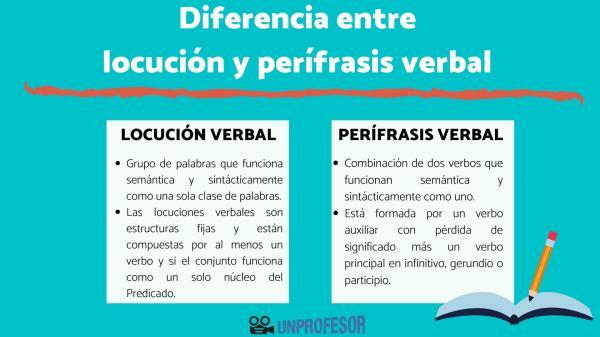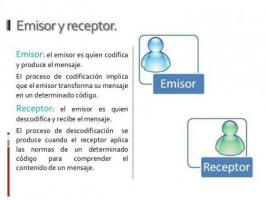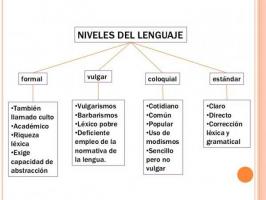Difference between a LOCUTION and a verbal PERIPHRASIS
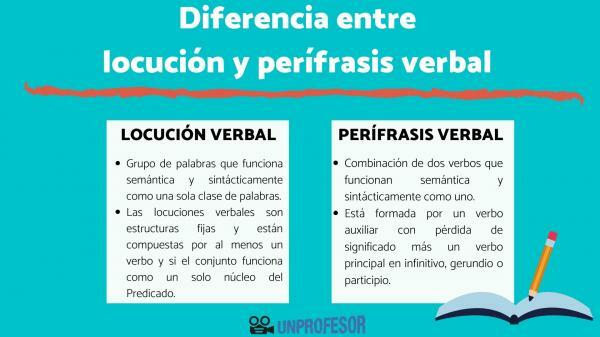
Spanish is a language that has a multitude of resources. Sometimes, when we state an action, we use a group of words that function as if they were a verb and fulfill the same functions as this. For this reason, it is not uncommon that one of the most frequent doubts among students is that of the difference between a verbal phrase and a verbal periphrase. In this lesson from a PROFESSOR we want to help you identify and differentiate them in a very simple way so that you do not have any doubts about it again.
This lesson focuses on knowing the difference between a verbal phrase and a verbal periphrase. To do this, it will be necessary to remember the definitions of these two concepts:
- Verbal locution: a locution is a group of words that works semantically and syntactically as a single class of words. Verb phrases are fixed structures and are composed of at least one verb and if the set functions as a single nucleus of the Predicate.
- Verbal periphrasis: it is a combination of two verbs that function semantically and syntactically as one. It is made up of an auxiliary verb with loss of meaning plus a main verb in the infinitive, gerund or participle.
Also, at the end of the lesson you can do the printable exercises with their solutions that we have left you on the web and that will surely help you to better understand this difference.
In the first place, in order to know what the difference is between them, we must define them. In this way we will better know how they work and what makes them different within a sentence.
So we can say that a verbal locution it's a lexical group made up of two or more words. These behave syntactically and semantically as if they were one. In other words, although these are made up of several words, the meaning will be the one produced by their union, not that of each one of them separately.
Verbal phrases can be of two types:
- Verbal phrases formed by a single verb
- Verbal phrases formed by two verbs
Verbal phrases formed by a single verb
These types of phrases are those that have a single verb. Next, we are going to mark this verb in bold and show the meaning of the phrase. So we can see that even if we do not find a group of words, eventually they all work as if they were one.
- Realize: understand
- Miss: yearn
- Facing: failing
- Realize: understand
- Take into account: contemplate, assess
- Shatter: break
Verbal phrases formed by two verbs
Verbal phrases are those that are made up of two verbs. Normally between these two a link appears that unites them and forms the locution. These types of phrases are the ones that usually generate the greatest doubts, especially when we want to differentiate them from verbal periphrasis. Let's see some examples:
- Spoil: spoil
- Make known: show
- Hint: hint
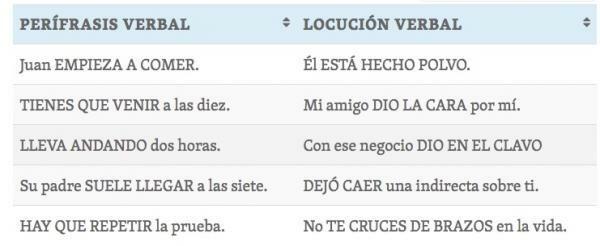
Image: Easy Language and Literature
A verbal periphrase is the combination of two verbs that they function semantically and syntactically as one. They are always composed of a conjugated auxiliary verb and a main verb. The conjugated verb loses part of its meaning and in the main verb in the infinitive, gerund or participle that becomes the semantic nucleus. Examples:
- I must go home
In this case, we find a conjugated or auxiliary verb that is I must, followed by another in the infinitive. In this periphrasis, the main verb is to go and therefore it is the nucleus. In this other example the same thing happens:
- Keep snowing
Now that we know what each of them are separately, let's see what their main differences are and how we can easily identify them through these simple tricks.
Trick 1
The locution always works as a fixed structure. Although it is made up of one or more verbs, there is no hierarchy between them. That is, there is no main and auxiliary verb. Example: The young woman blamed her boyfriend for her disappointments. In this case, reproaching it is identified as a single concept that functions as the core of the verb phrase.
When we have a verbal periphrase, we find a main verb and an auxiliary verb. That is, the main one will be the one that gives meaning to the sentence. Let's see an example to understand it better: The boy began to cry. In this case the main verb is going to be crying and the auxiliary was put.
Trick 2
The locution always equates to a single idea. In other words, even if we find this set of words within a sentence, they will work as one, as a single concept. It can be summarized, therefore, in a single synonymous verb without losing nuances.
- Spoil: equals spoil
- Make known: is equal to show
In the case of verbal periphrasis, although they can be replaced by a verb, it will present a loss of nuances that there was not in the previous case. Let's see it with an example: Javier is going out. If we modify this sentence and replace the periphrasis with a single verb, we find the following: Javier will leave. In this case we already have a loss of nuances, that is, that beginning of action marked by the verb go plus the preposition is lost.
Trick 3
Some verb phrases have a peripheral origin, which means that they were originally periphrasis, but that after the passage of time and its use they have fossilized in the language to end up becoming an expression or locution. For example:
- Go you / go to know
- To drop (in a place)
In these cases, the best tool to identify them is to use a dictionary to really know what they are.
Tip 4
It is the easiest to apply, so we could consider it as the definitive trick to know the difference between the two. Verbal phrases do not allow changes, since they are fixed structures, they always appear in the same way. That is, they are expressions of the language. Let's see some examples to understand it better:
- Missing: we cannot say missing out.
- To spoil: it cannot be to spoil.
- To throw in face: it cannot become throw in the feet.
- Know for sure: we cannot use knowing for sure.
On the other hand, the periphrasis do allow changes in its structure. Let's see it with examples so you can easily identify them. In the periphrasis hate, we can apply different changes: I am going to leave / enter / dance / play, etc.
As you can see, with these little tips you will be able to differentiate a verbal phrase from a verbal periphrase in a simple and intuitive way. If you want to continue learning, do not miss the content that we offer you in our Spanish Language section.
